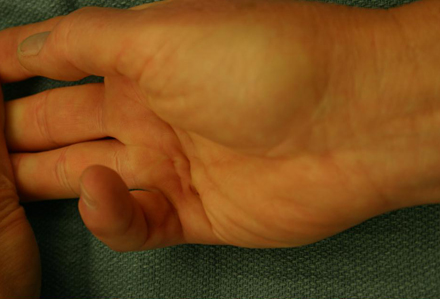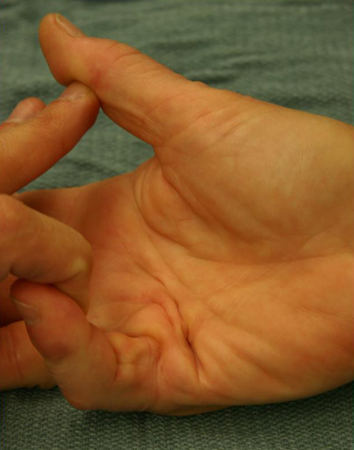History and exam
Key diagnostic factors
common
presence of risk factors
Risk factors for Dupuytren's contracture include a family history of the disease, diabetes mellitus, anticonvulsant therapy, smoking, alcohol, and trauma.
male >40 years of age
difficulties with manual activities
Patients describe difficulties with face washing, combing their hair, and putting their hands in their pockets or fitting them into gloves.[19]
palmar nodule
A firm and thickened palmar nodule over the metacarpal head at the level of the distal palmar crease, proximal to the metacarpophalangeal (MCP) joint, is often the earliest sign.
Nodules may be associated with a band in the palmar aponeurosis.
palmar skin changes
After nodule formation, skin changes occur, with skin thickening, tethering, puckering, or pitting, as well as subcutaneous fat fibrosis.
pretendinous cords
The formation of pretendinous cords usually occurs as isolated nodules coalesce, although nodules and cords can be present simultaneously.
The most commonly affected digit is the ring finger, followed by the small finger, thumb, middle finger, and index finger.
MCP joint contracture
As pretendinous cords in the palm progress they may travel across the MCP joint and, over time, produce MCP joint flexion contractures, leading to limited extension of the affected finger. [Figure caption and citation for the preceding image starts]: Preoperative view of a small finger flexion contracture with surgical indicationsFrom the collection of Dr C.M. Rodner; used with permission [Citation ends]. [Figure caption and citation for the preceding image starts]: Preoperative view of a small finger flexion contracture with surgical indicationsFrom the collection of Dr C.M. Rodner; used with permission [Citation ends].
[Figure caption and citation for the preceding image starts]: Preoperative view of a small finger flexion contracture with surgical indicationsFrom the collection of Dr C.M. Rodner; used with permission [Citation ends].
The degree of contracture is dependent on the severity of the disease.
proximal interphalangeal (PIP) joint contracture
Digital cords that cross the PIP joint may cause PIP joint contractures.
positive Hueston table-top test
Involves the patient attempting to lay the palm of the hand flat on a table surface.
The result is positive if the patient is unable to flatten the hand on the table.
Other diagnostic factors
common
bilateral involvement
Bilateral hand involvement is common, with one hand usually more severely affected than the other, although the handedness of the patient is not a predictor of severity.
Patients with Dupuytren's diathesis have rapid disease progression involving both hands.
uncommon
Garrod's nodes
Examination of the dorsal aspect of the PIP joints may reveal areas of subcutaneous fibrosis, known as Garrod's nodes, or knuckle pads, which are indicative of systemic fascial disease and predictive of bilateral involvement.
Garrod's nodes are found in about one half of patients.
involvement of plantar surface of the feet
Patients with Dupuytren's diathesis are more likely to have systemic fascial disease, including Ledderhose's disease, which affects the plantar surface of the feet.
involvement of penis
Patients with Dupuytren's diathesis are more likely to have systemic fascial disease, including Peyronie's disease in men, which affects the penis.
Risk factors
strong
male sex
age >40 years
family history
Dupuytren's contracture is believed to show autosomal dominant inheritance with variable penetrance.[1]
The familial occurrence and its presence in identical twins suggest a genetic basis for the disease. The sibling recurrence risk ratio equals 2.9 (95% CI 2.6 to 3.3).
Although the genetic factors involved have not been fully elucidated, in one family the gene has been mapped to chromosome 16q.[1]
DNA microarray has demonstrated that >30 unique genes are upregulated and 6 unique genes downregulated by a factor of 4 or greater in affected patients.[11]
A novel gene, MafB (musculoaponeurotic fibrosarcoma oncogene homolog B), is overexpressed in patients with Dupuytren's contracture but not in those with normal fascia.[11]
diabetes mellitus
Diabetes mellitus has a strong association with Dupuytren's contracture.[4][10][14][15][16] The prevalence of Dupuytren's contracture in patients with diabetes ranges from 3% to 33% and increases with the duration of the diabetes.
It is hypothesised that diabetes causes microvascular changes that produce local hypoxic tissue damage, inducing Dupuytren's contracture. Patients with diabetes tend to have a mild form of the disease with slow progression.
weak
high alcohol intake
smoking
For unclear reasons, smoking increases the risk of Dupuytren's contracture, although the microvascular changes associated with smoking and the effect of carbon monoxide on mitochondrial cytochrome c, released by mitochondria in response to pro-apoptotic stimuli, may play a role.[17]
trauma
Trauma was first proposed to be a cause by Dupuytren himself. Since the first report that linked trauma to the disease, the strength of this association has been controversial. It is unclear why the disease would be caused by heavy labour or vibrational exposure, and further studies are required to control for smoking and alcohol use.
One theoretical explanation for the connection of trauma and Dupuytren's contracture is the induction of transforming growth factor-beta (TGF-b) with trauma and the stimulation of myofibroblasts from the increased TGF-b.[21]
anticonvulsant medication
There have been reports of a connection between epilepsy and Dupuytren's contracture. When discontinuing anticonvulsant drugs, findings such as palmar cords and knuckle pad thickening have been reported to regress, although large cohort studies have not found an association with epilepsy or epilepsy medication and the disease. It would seem that epilepsy is not a risk for the disease, but anticonvulsant drugs (phenytoin and carbamazepine) may trigger it.[20]
Use of this content is subject to our disclaimer